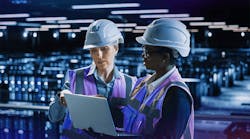What Rehlko’s 2025 Powering Impact Report Tells Us About the Future of Data Center Energy
A New Kind of Resilience
For decades, “resilience” in digital infrastructure meant one thing: uptime. Generators hum, UPS systems stand guard, and equipment is ready to keep things running in the event of an unplanned outage. It was a simple formula, until it wasn’t.
In 2025, power demand is no longer just an operational challenge. It has become the defining test of whether our industry can continue to grow responsibly, balancing progress with social and environmental accountability.
Artificial intelligence has pushed digital infrastructure into uncharted territory. High-density computing and round-the-clock workloads are straining power systems designed for a different era. Meanwhile, communities, regulators, and investors are demanding more transparency and accountability. Energy is no longer a back-of-house line item; it is the front-page story.
At Rehlko, our inaugural Powering Impact Report lays out both the progress we’ve made and the lessons that should shape the industry’s future. The message is clear: the world doesn’t just need more energy. It needs smarter energy, and fast.
Transparency Will Reshape the Market
Let’s start with transparency. For too long, power procurement has been a black box. Operators had to make choices with limited data, relying on supplier claims rather than standardized proof. That era is ending.
In 2024, Rehlko published the market’s first Environmental Product Declaration (EPD) for mission-critical generators. This isn’t just a certificate to hang on the wall. It’s a third-party verified, lifecycle-based account of a product’s embodied carbon and environmental footprint. It gives operators the ability to measure Scope 3 emissions, compare options, and align procurement with sustainability goals.
Here’s the prediction: within five years, EPDs and Life Cycle Assessments will become table stakes. Just as uptime SLAs once redefined expectations for reliability, environmental transparency is now poised to reshape how operators evaluate and select their power partners. The next wave of vendor relationships will be built on proof of impact, not just promises. Operators will expect suppliers to prove their impact, not just promise sustainability.
For digital infrastructure, that’s not a burden; it’s an accelerant. Transparency forces innovation. By digging into lifecycle data for our KD Series generators, we identified design changes that lowered weight, improved transient performance, and positioned them for future Hydrotreated Vegetable Oil (HVO) compatibility. That’s the power of shining a light on the numbers.
Maintenance is a Key Part of the Sustainability Frontier
When people think about decarbonization, they often imagine futuristic hydrogen fuel cells or massive renewable installations. But sometimes the biggest wins come from rethinking the everyday.
Take generator maintenance. Traditional testing protocols were built for reliability, not sustainability. They consume fuel, emit greenhouse gases, and add costs. By contrast, our Conscious Care program retools maintenance cycles with no-load testing and smarter schedules. The results: up to 72% less fuel consumed and 70% fewer emissions over a maintenance cycle without compromising resilience.
This is where the industry has untapped potential. Operations and maintenance (O&M) have long been seen as a cost center, a box to check. But what if we viewed O&M as a carbon lever? What if every service contract came with emission reduction KPIs alongside reliability metrics?
In an industry racing to meet net-zero pledges, we can’t afford to leave these gains on the table. Maintenance may not be flashy, but it’s one of the most scalable, immediate ways to cut emissions today.
Hybrid Energy Is the New Normal
Of course, we can’t maintain our way out of the power challenge. The scale of AI-driven demand requires new thinking about how we generate and deliver resilience.
Here’s the reality: there is no single silver bullet. The future is hybrid.
We’re already seeing it in action. In Washington State, Rehlko and Toyota partnered to deliver a hydrogen fuel cell system for a regional hospital, demonstrating its reliability in mission-critical applications. As a zero-emission backup solution, it's now being scaled to meet the growing power demands of customers such as data centers. In France, our Brest facility switched entirely to HVO, cutting site-level emissions in half. Across our global plants, we’ve added solar and battery storage systems from China to Italy, integrating renewable self-generation into daily operations.
Each of these solutions does a different job. Some deliver immediate emission cuts. Others test the boundaries of future fuels like hydrogen and HVO. Still others provide modular resilience to stabilize AI-driven spikes.
The prediction here is simple: the data center of 2030 will not run on diesel backup alone. The facilities that try will lose, on sustainability, on community trust, and eventually on regulatory compliance. Winning in the next era means building a toolkit of power options that can flex with technology, policy, and demand.
Focus Is the Quiet Differentiator
Technology and operations may get the spotlight, but focus will decide who leads. Transparency and resilience require strong systems, clear accountability, and credible voices to carry the message.
That’s why, in 2024, we conducted our first double materiality assessment examining how sustainability issues affect Rehlko from the outside-in (financial risks) and inside-out (our impacts on people and the planet). It’s why we built a dedicated sustainability governance team under a Chief Brand & Sustainability Officer, and why we convened our first global Powering Impact sustainability summit to align every business unit.
Leadership also means stepping up beyond our own walls. In 2025, Rehlko’s Louis Liu became Co-Chair of the iMasons Climate Accord Equipment Working Group, where he’s helping the entire sector align on embodied carbon methodologies. That kind of collaboration sets the standard for what industry leadership should look like.
The takeaway is that resilience isn’t just a product spec. It’s a focused system. The operators and suppliers who embrace this will build trust, win partnerships, and shape regulation rather than chase it.
Why This Matters More Than Ever
So why should the industry care more about power now, when it’s always been part of the conversation? Because the stakes have changed.
Without smarter energy, growth will stall. Communities have made social license the new gatekeeper. Without transparency, projects will be delayed, protested, or denied. And investors have made sustainability performance a condition for capital. Without credible governance, funding will dry up.
Power is no longer just about keeping servers online. It’s about keeping the industry’s future viable.
The Call to Action
Rehlko’s Powering Impact report shows what’s possible:
- 90% reduction target for Scope 1 and 2 emissions by 2045.
- 946 tons of CO₂ avoided in Brest through HVO conversion.
- 4 GW of renewable energy deployed by Clarke Energy globally.
These aren’t theoretical ambitions. They’re proof points that resilience and sustainability can, and must, go hand in hand.
But here’s the truth: no single company can carry this burden alone. The industry must shift from a mindset of “more power at any cost” to one of smarter power at every step. That means demanding transparency in procurement, embedding carbon reduction in O&M, and embracing hybrid toolkits that make resilience both reliable and responsible.
As we look to 2026 and beyond, the question isn’t whether we’ll solve the power challenge. It’s whether we’ll do it in a way that earns the trust of our customers, our communities, and our planet.
Because in the end, the world doesn’t just need more data. It needs an energy-resilient digital infrastructure that can carry its own weight, socially, environmentally, and economically. That’s the future we’re building at Rehlko, and it’s the future we must all demand.
About the Author

Ryan DeLoge
Ryan DeLoge is the Sustainability Manager for Rehlko, where he helps to lead corporate sustainability strategy and reporting across the company’s core businesses. With nearly 9 years of experience advancing sustainability and resiliency initiatives, Ryan focuses on the intersection of sustainability, innovation, and business performance, helping position Rehlko as a trusted partner in Creating an Energy Resilient World for a Better Future
He holds a degree in Environmental Studies with a Sustainability Management minor and a Policy and Values emphasis from the University of Wisconsin–Oshkosh. A lifelong outdoor enthusiast, Ryan is passionate about bridging sustainability goals with real-world business impact to strengthen both brand and planet.



